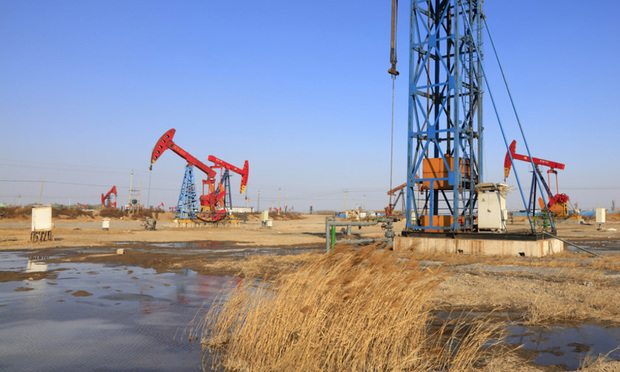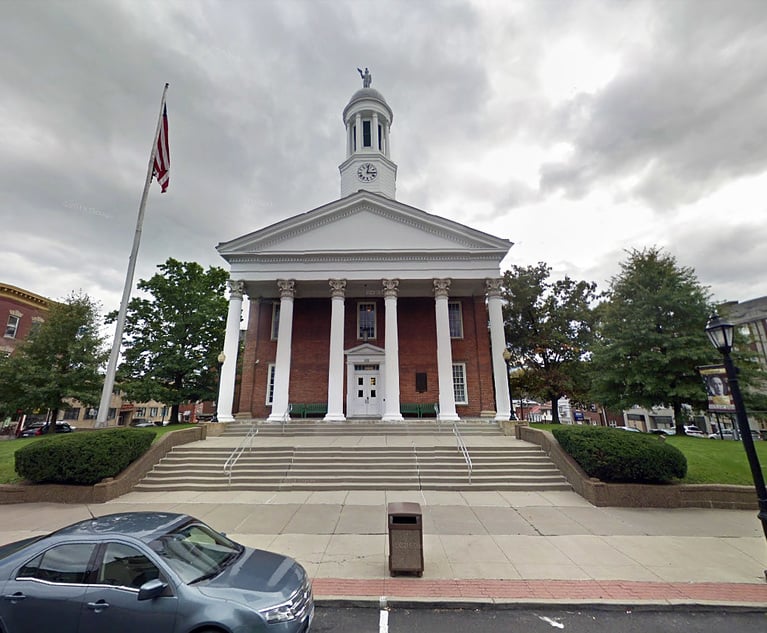Justices to Decide Whether Rule of Capture Applies to Fracking
The Pennsylvania Supreme Court is set to determine whether the rule of capture, which precludes trespass liability for drillers where oil and gas drains from surrounding lands in the course of conventional extraction from an underground pool, applies where shale gas is extracted through hydraulic fracturing.
November 21, 2018 at 08:35 AM
6 minute read
 Photo credit: junrong / Shutterstock.com
Photo credit: junrong / Shutterstock.com
The Pennsylvania Supreme Court is set to determine whether the rule of capture, which precludes trespass liability for drillers where oil and gas drains from surrounding lands in the course of conventional extraction from an underground pool, applies where shale gas is extracted through hydraulic fracturing.
In an apparent case of first impression, the Pennsylvania Superior Court ruled earlier this year that it does not.
On Nov. 20, the high court issued a one-page order agreeing to consider a single question on appeal: “Does the rule of capture apply to oil and gas produced from wells that were completed using hydraulic fracturing and preclude trespass liability for allegedly draining oil or gas from under nearby property, where the well is drilled solely on and beneath the driller's own property and the hydraulic fracturing fluids are injected solely on or beneath the driller's own property?”
The case has drawn heavy amicus interest from industry organizations including the Marcellus Shale Coalition, the American Exploration & Production Council, the Pennsylvania Chamber of Business and Industry, the Pennsylvania Independent Oil & Gas Association, the Independent Petroleum Association of America and the American Petroleum Institute.
In a published opinion issued April 2 in Briggs v. Southwestern Energy Production, a two-judge panel of the Superior Court reversed a Susquehanna County trial judge's decision granting summary judgment to defendant Southwestern Energy Production Co. on claims of trespass and conversion by a group of property owners.
The property owners alleged that Southwestern had unlawfully extracted gas from beneath their property while drilling on an adjoining property.
While Southwestern invoked the rule of capture in its defense, the Superior Court said the rule was inapplicable to hydraulic fracturing (also known as fracking), a process by which high-pressure liquid is used to forcibly extract natural gas from shale.
“In light of the distinctions between hydraulic fracturing and conventional gas drilling, we conclude that the rule of capture does not preclude liability for trespass due to hydraulic fracturing,” Senior Judge John L. Musmanno Jr. wrote for the panel. “Therefore, hydraulic fracturing may constitute an actionable trespass where subsurface fractures, fracturing fluid and proppant cross boundary lines and extend into the subsurface estate of an adjoining property for which the operator does not have a mineral lease, resulting in the extraction of natural gas from beneath the adjoining landowner's property.”
Musmanno was joined by President Judge Susan Peikes Gantman. Judge Mary Murray was also listed as a member of the panel but the opinion said she did not participate in the consideration or decision of the case.
In considering whether hydraulic fracturing that extracts gas from beyond the boundaries of a leased property could be considered a trespass, the Superior Court looked to rulings by the Texas Supreme Court and the U.S. District Court for the Northern District of West Virginia for guidance.
In the 2008 case Coastal Oil & Gas v. Garza Energy Trust, the Texas Supreme Court held that the rule of capture barred liability for drainage by hydraulic fracturing, just as it did for drainage by conventional oil and gas production methods. But Justice Phil Johnson dissented, arguing that “the gas at issue … did not migrate to Coastal's well because of naturally occurring pressure changes in the reservoir” and stating that he ”would not apply the rule [of capture] to a situation … in which a party effectively enters another's lease without consent, drains minerals by means of an artificially created channel or device, and then 'captures' the minerals on the trespasser's lease.”
In the 2013 case Stone v. Chesapeake Appalachia, the U.S. District Court for the Northern District of West Virginia, persuaded by Johnson's dissent in Coastal Oil, found the rule of capture was inapplicable to hydraulic fracturing and criticized the Coastal Oil majority's opinion as giving “oil and gas operators a blank check to steal from the small landowner.”
“Under such a rule, the companies may tell a small landowner that either they sign a lease on the company's terms or the company will just hydraulicly fracture under the property and take the oil and gas without compensation,” the Stone court said.
Musmanno said the Superior Court found both Johnson's Coastal Oil dissent and the Stone ruling persuasive, noting the fundamental difference between fracking and conventional oil and gas production, which the rule of capture was originally intended to cover.
“Unlike oil and gas originating in a common reservoir, natural gas, when trapped in a shale formation, is non-migratory in nature,” he said. “Shale gas does not merely 'escape' to adjoining land absent the application of an external force. Instead, the shale must be fractured through the process of hydraulic fracturing; only then may the natural gas contained in the shale move freely through the 'artificially created channel[s].'”
Like Johnson and the Stone court, the Superior Court disagreed with the Coastal Oil court's rationale that a landowner could protect his interests by drilling his own well to prevent drainage into adjacent properties.
“Hydraulic fracturing is a costly and highly specialized endeavor, and the traditional recourse to 'go and do likewise' is not necessarily readily available for an average landowner,” Musmanno said.
Musmanno also echoed Johnson's and the Stone court's concerns “that precluding trespass liability based on the rule of capture would effectively allow a mineral lessee to expand its lease by locating a well near the lease's boundary line and withdrawing natural gas from beneath the adjoining property, for which it does not have a lease.”
“Such an allowance would nearly eradicate a mineral lessee's incentive to negotiate mineral leases with small property owners, as the lessee could use hydraulic fracturing to create an artificial channel beneath an adjoining property, and withdraw natural gas from beneath the neighbor's land without paying a royalty,” Musmanno said.
In reversing the lower court's grant of summary judgment and remanding the case, the Superior Court said the plaintiffs must be given an opportunity to develop their trespass and conversion claims.
Reached Nov. 20, counsel for the plaintiffs, Laurence Kelly of Kelly Law Office in Montrose, said of the high court's allocatur grant, “I'm just looking forward to presenting my client's case in the Supreme Court.”
Southwestern's counsel, Robert Byer of Duane Morris in Pittsburgh, referred comment to his client. A Southwestern spokesperson said in a statement, “We appreciate the court's thoughtful decision to review this ruling, especially given the case's potential to negatively impact Pennsylvanians who depend on natural gas for royalty payments, jobs and affordable energy. Bringing legal clarity and certainty to this potentially far-reaching matter—while avoiding pitting neighbor against neighbor in costly and speculative legal disputes that could unnecessarily overburden our courts—are top priorities for Southwestern Energy.”
This content has been archived. It is available through our partners, LexisNexis® and Bloomberg Law.
To view this content, please continue to their sites.
Not a Lexis Subscriber?
Subscribe Now
Not a Bloomberg Law Subscriber?
Subscribe Now
NOT FOR REPRINT
© 2025 ALM Global, LLC, All Rights Reserved. Request academic re-use from www.copyright.com. All other uses, submit a request to [email protected]. For more information visit Asset & Logo Licensing.
You Might Like
View All
Plaintiff Argues Jury's $22M Punitive Damages Finding Undermines J&J's Talc Trial Win
4 minute read
Pa. High Court: Concrete Proof Not Needed to Weigh Grounds for Preliminary Injunction Order
4 minute read
Superior Court Directs Western Pa. Judge to Recuse From Case Over Business Ties to Defendant
3 minute read
Seven Rules of the Road for Managing Referrals To/From Other Attorneys, Part 2
6 minute readTrending Stories
- 1No Two Wildfires Alike: Lawyers Take Different Legal Strategies in California
- 2Poop-Themed Dog Toy OK as Parody, but Still Tarnished Jack Daniel’s Brand, Court Says
- 3Meet the New President of NY's Association of Trial Court Jurists
- 4Lawyers' Phones Are Ringing: What Should Employers Do If ICE Raids Their Business?
- 5Freshfields Hires Ex-SEC Corporate Finance Director in Silicon Valley
Who Got The Work
J. Brugh Lower of Gibbons has entered an appearance for industrial equipment supplier Devco Corporation in a pending trademark infringement lawsuit. The suit, accusing the defendant of selling knock-off Graco products, was filed Dec. 18 in New Jersey District Court by Rivkin Radler on behalf of Graco Inc. and Graco Minnesota. The case, assigned to U.S. District Judge Zahid N. Quraishi, is 3:24-cv-11294, Graco Inc. et al v. Devco Corporation.
Who Got The Work
Rebecca Maller-Stein and Kent A. Yalowitz of Arnold & Porter Kaye Scholer have entered their appearances for Hanaco Venture Capital and its executives, Lior Prosor and David Frankel, in a pending securities lawsuit. The action, filed on Dec. 24 in New York Southern District Court by Zell, Aron & Co. on behalf of Goldeneye Advisors, accuses the defendants of negligently and fraudulently managing the plaintiff's $1 million investment. The case, assigned to U.S. District Judge Vernon S. Broderick, is 1:24-cv-09918, Goldeneye Advisors, LLC v. Hanaco Venture Capital, Ltd. et al.
Who Got The Work
Attorneys from A&O Shearman has stepped in as defense counsel for Toronto-Dominion Bank and other defendants in a pending securities class action. The suit, filed Dec. 11 in New York Southern District Court by Bleichmar Fonti & Auld, accuses the defendants of concealing the bank's 'pervasive' deficiencies in regards to its compliance with the Bank Secrecy Act and the quality of its anti-money laundering controls. The case, assigned to U.S. District Judge Arun Subramanian, is 1:24-cv-09445, Gonzalez v. The Toronto-Dominion Bank et al.
Who Got The Work
Crown Castle International, a Pennsylvania company providing shared communications infrastructure, has turned to Luke D. Wolf of Gordon Rees Scully Mansukhani to fend off a pending breach-of-contract lawsuit. The court action, filed Nov. 25 in Michigan Eastern District Court by Hooper Hathaway PC on behalf of The Town Residences LLC, accuses Crown Castle of failing to transfer approximately $30,000 in utility payments from T-Mobile in breach of a roof-top lease and assignment agreement. The case, assigned to U.S. District Judge Susan K. Declercq, is 2:24-cv-13131, The Town Residences LLC v. T-Mobile US, Inc. et al.
Who Got The Work
Wilfred P. Coronato and Daniel M. Schwartz of McCarter & English have stepped in as defense counsel to Electrolux Home Products Inc. in a pending product liability lawsuit. The court action, filed Nov. 26 in New York Eastern District Court by Poulos Lopiccolo PC and Nagel Rice LLP on behalf of David Stern, alleges that the defendant's refrigerators’ drawers and shelving repeatedly break and fall apart within months after purchase. The case, assigned to U.S. District Judge Joan M. Azrack, is 2:24-cv-08204, Stern v. Electrolux Home Products, Inc.
Featured Firms
Law Offices of Gary Martin Hays & Associates, P.C.
(470) 294-1674
Law Offices of Mark E. Salomone
(857) 444-6468
Smith & Hassler
(713) 739-1250





